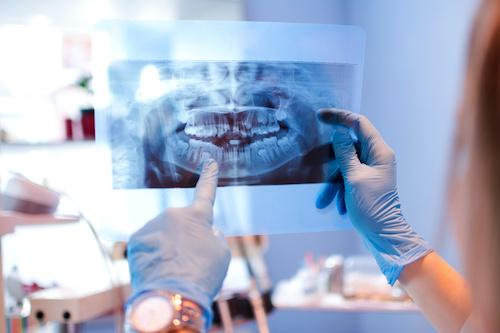Root Resorption Treatment
Root resorption is a process where tissues surrounding a tooth start to break down and are reabsorbed by the body. The two most common types of resorption are internal and external.
As skilled endodontists in Camp Hill, PA, Dr. Darrell Curtis and Dr. Shane Curtis specialize in diagnosing and treating root resorption. You can be confident that your care is in excellent hands and that they are committed to providing the comprehensive treatment you need.
Two Types of Resorption: External and Internal
 External cervical resorption (ECR) is most common. It can affect any part of the outside of a tooth, typically beginning at the outer surface near the gum line and working its way inward.
External cervical resorption (ECR) is most common. It can affect any part of the outside of a tooth, typically beginning at the outer surface near the gum line and working its way inward.
Internal resorption is less common and affects tissues inside the tooth. It often begins at the root due to chronic pulp inflammation but can also result from swelling inside the pulp area due to an untreated cavity.
Causes for Root Resorption
Root resorption is most prevalent in those aged 21–30 and commonly affects more women than men. While the exact nature of ECR isn’t fully understood, there are factors associated with the condition, including:
- Excessive pressure and tension on teeth resulting from orthodontic treatment.
- Trauma that damages periodontal ligaments and causes swelling and loss of bone and tissue on and around a tooth.
- Extreme teeth grinding that damages gum ligaments
- Excessive teeth bleaching with non-professional products
However, having these risk factors does not automatically mean you will develop resorption.
Symptoms of Root Resorption
Resorption is often asymptomatic, and patients are unaware it exists until their dentist notes dark spots on a routine x-ray. However, the following are some common symptoms patients experience:
- Pinkish tint or spots on the tooth
- Pain that radiates from inside the tooth
- Red or swollen gums
- Loose teeth
- Weak or brittle teeth
- Cavity-like holes on the tooth at or near the gumline
- Tooth shifting that creates irregular spaces
Why Treating Resorption Is Important
The longer root resorption goes untreated, the further the damage progresses, and erodes increasing amounts of the tooth’s inner and outer root structure. Without treatment, tooth resorption complications develop quickly and cause lasting dental damage, including:
- Infections
- Crooked teeth
- Weak teeth
- Tooth discoloration
- Tooth loss
- Root recession
How Our Endodontists Diagnose Resorption
 The first step to diagnose tooth resorption is a comprehensive endodontic evaluation by Dr. Darrell or Dr. Shane. They will discuss your dental history and ask if you’ve experienced past injuries or had procedures done on the tooth
The first step to diagnose tooth resorption is a comprehensive endodontic evaluation by Dr. Darrell or Dr. Shane. They will discuss your dental history and ask if you’ve experienced past injuries or had procedures done on the tooth
Next, they examine the tooth and take high-resolution digital x-rays and 3-D cone beam CT scans to evaluate the extent of resorption and the damage it has caused
Treatment for Dental Resorption
Fortunately, resorption can be treated effectively by our experienced endodontists if addressed promptly. The priority is to remove the affected tooth structure to minimize the risk of further resorption, and restore the tooth to function.
Because the reasons for dental resorption vary widely, our Dr. Darrell and Dr. Shane tailor your treatment to provide the optimal results for your specific needs.
Sometimes, if the lesion is small, they may recommend minor periodontal (gum) surgery to treat the affected area. If damage extends to the tooth’s pulp, root canal treatment may be necessary. However, in a case where resorption is so extensive that a root canal won’t save the tooth our endodontists would recommend removing and replacing it.
Do You Need Root Resorption Treatment?
If your dentist told you that you need an endodontist to evaluate suspected root resorption, Dr. Darrell and Dr. Shane would be happy to provide their recommendations. Please call Curtis Endodontics in Camp Hill, PA, at (717) 550-4040.


